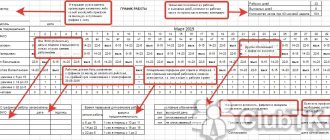A shift work schedule is a special scheme for distributing working time in an organization, in which the working day can exceed 8 hours. At the same time, special requirements apply to rest, wages and the distribution of shifts between employees.
Someone works from Monday to Friday from 9.00 to 18.00, has an hour lunch break and salary. And someone, when applying for a job, hears that the organization has established a shift schedule in accordance with the Labor Code of the Russian Federation. What is better, working in shifts or as usual? What is a shift schedule? What types of it exist and are permitted by labor legislation? And how do they pay for such work?
What the Labor Code says
Russian legislation allows employers to establish a shift work schedule; according to the Labor Code of the Russian Federation, it is possible in case of production necessity, subject to the rights of employees. Article 103 of the Labor Code of the Russian Federation prohibits one person from working two shifts in a row, and Article 110 of the Labor Code of the Russian Federation establishes that the work schedule during shift work takes into account at least 42 hours of continuous rest per week for each employee.
The employer is obliged to keep strict records of working hours and monitor that all working time limits and wages, including for official weekends and holidays, are observed. Special requirements are established for night work.
Features of working on a shift schedule
Shift work involves certain features that distinguish it from other work modes. In particular, this applies to the night shift, which may also be implied by an agreement between the participants in the labor relationship. So, if an employee goes to work from 22:00 to 6:00 in the morning, then his working hours are reduced by 60 minutes. In this case, the person is not obligated to work this time on another shift.
In addition, an employment contract involving shift work must contain a list of categories of workers who cannot be involved in night work:
- pregnant women;
- minors, but with the exception of creative employees;
- other entities whose prohibition on working at night is prescribed in local regulations.
It should also be noted that if the organization provides payment for specific hours worked by an employee in a shift, then working on holidays requires double payments. Accordingly, if the shift lasted 12 hours, then payment should be accrued for 24 hours. The employment contract must also contain such conditions, otherwise it will be considered void.
To summarize, it must be said that shift work is one of the preferred ways of organizing work in enterprises where it is impossible to stop the production cycle for even a single minute.
When is it applied?
The employer establishes a continuous operating mode in the organization if it is necessary for him to operate the enterprise and obtain maximum profit. Article 130 of the Labor Code of the Russian Federation defines that production necessity means:
- the duration of the production process is higher than the permissible daily norm (8 hours);
- efficient use of equipment to increase production volume.
In other words, if management believes that the company should work 12 hours a day or around the clock, work on a shift schedule is introduced; the Labor Code of the Russian Federation does not provide for restrictions on making such a decision. Hospitals, police and the Ministry of Emergency Situations always work in this mode, there are plants and factories with a continuous production cycle, airports, train stations, and convenience stores.
What kind of shifts are there?
The employer varies the shifts at his discretion, observing the requirements for their maximum duration and rest schedule. The legislation allows for work in 2, 3 or 4 shifts. Nighttime alternates with daytime. The most common combinations are:
- a day shift of 12 hours, rest at night, another shift of 12, then two days of rest, this is called two after two;
- a day shift lasting 12 hours, a day of rest, then another shift. This is called a 1-1 work schedule, it’s like one day is working, the other is a day off;
- work 24 hours, rest 48, or every other day (every other day);
- night shift 12 hours, 24 hours rest.
Variations are possible, depending on the needs of the organization and its specifics. There are even shifts of 3 every 3 hours during the day, and then a day off.
Separately, keep in mind that a special operating mode of an organization in which employees do not replace each other at the workplace is not considered a shift schedule. For example, shifting weekends from Saturday and Sunday to other days of the week.
How to make a duty schedule in word
Hello, in this article we will try to answer the question “How to make a duty schedule in Word.” You can also consult with lawyers online for free directly on the website.
In Word 2003 the process happens differently. To create tables in the old version, a separate menu is used.
Dear readers! Our articles talk about typical ways to resolve legal issues, but each case is unique. The essence of creating a duty schedule is to organize the activities of employees in one position, replacing each other with a specific frequency.
How to enter a shift schedule
The management of the organization does not have the right to simply say:
Starting tomorrow we will work like this!
There is an algorithm that everyone, without exception, must adhere to. According to the law, you should act like this:
- Issue an order for the organization to switch to such a schedule.
- Write down in the internal labor regulations - determine the number of shifts per day, set the duration of each of them.
- Prepare and approve the shift schedule.
- Familiarize shift workers with it at least a month before changing the regime.
- Fix the condition in employment contracts with employees by concluding additional agreements.
It is not necessary to issue an order to switch to such a schedule; there is no such requirement in labor legislation. If this document does exist, it will be drawn up in any form. In it, indicate the positions for which such a regime is established, the timing and procedure for its introduction.
Additional agreements to employment contracts must be concluded with all shift workers. A sample of such an agreement looks like this:
Coordination with employees
Article 102 of the Labor Code of the Russian Federation defines the requirement to coordinate the start and end times of shifts and the total duration of work. If the organization has a trade union, its opinion should be taken into account. For some categories of workers, special conditions must be taken into account:
- for disabled people, the maximum working time is determined by a medical report (Part 1 of Article 94 of the Labor Code of the Russian Federation);
- for minors - 5 and 7 hours (15-16 and 16-18 years old, respectively) with a ban on working at night;
- for persons combining study and work - no more than 3.5 hours;
- for workers employed in hazardous industries - a maximum of 8 hours;
- for pregnant women - no night shifts.
Night work is prohibited for the following categories of workers, unless they themselves write written consent to it:
- women with a child aged 0 to 3 years;
- disabled people;
- persons with dependent disabled children;
- workers who care for sick family members;
- single parents and guardians of children under 5 years of age.
The team should explain what a shift work schedule means, talk about the features of the work and rest schedule, their rights and responsibilities. It is also required to inform about the employer’s right to dismiss those who refuse to work under the new regime (with the exception of categories protected by law). The employee is recognized as familiar with the schedule when he puts his signature and date in the addendum to the employment contract and on the shift schedule itself. Also, a mark of familiarization is affixed in a special journal. If the employee refuses to sign the document, a report should be drawn up.
How is the operating mode interpreted?
Working time itself is the period during which an employee must perform his assigned duties. An employee must strictly follow the rules of the organization where he is employed.
Working hours - distribution of working hours within a day or other calendar period.
https://dic.academic.ru/dic.nsf/business/11347
Any organization has a working time schedule for employees.
Mode elements
The labor regime includes several components:
- length of shift or working day;
- time for rest during the shift;
- hours of work per week;
- rest between shifts;
- legal holidays.
The legislative framework of our country, in particular the Labor Code of the Russian Federation, provides for the maximum duration of the above elements. And also the length of the working day is additionally fixed in employment contracts. The labor regime differs for workers in different fields, i.e. it directly depends on the specifics of the organization and the industry in which this organization is involved. The differences are contained in the agreement between the employer and the employee. Most often, a standard schedule is used, which involves a five-day work week of 8 hour shifts. In those enterprises where it is important to ensure a continuous work process, a shift schedule is practiced, as well as total time tracking for a certain period.
What are the working hours?
According to the Labor Code of the Russian Federation, there are several types of labor regime:
- standard (normalized);
- irregular;
- flexible;
- removable;
- shift worker;
- fragmented;
- incomplete or abbreviated.
The legislation of the Russian Federation provides for several types of operating modes
Standard schedule
The normal schedule involves working 40 hours per week. This period does not depend on how many days a week the employee works. If an employee works 5 days a week, then he must be given 2 days to rest. In this case, the working day will be equal to 8 hours. If the work week lasts 6 days with 1 day for rest, then the working day will be 7 hours. It is worth considering that the day before the weekend in this case is considered shortened and lasts 5 hours. The standard work schedule is the most common and, as practice shows, is most often used by employers (especially government agencies and service companies).
Irregular schedule
The legislation of our country does not stipulate how many hours constitute an irregular day. In some cases, an employee works more than 40 hours a week, but only by prior agreement between him and the employer. In this case, processing cannot last more than 4 hours in 2 days (consecutive) and 120 hours in a calendar year. An employee may spend not only a regular working day performing his duties, but also the time before or after it. Such a work schedule is short-term in nature, i.e. it is used by management only from time to time, but the employee does not have the right to refuse to carry it out (if this activity does not contradict the responsibilities specified in the employment contract). An irregular schedule implies a further increase in the employee’s vacation.
An irregular schedule can harm an employee’s health, so constant work in such a mode is unacceptable
Flexible schedule
A sliding schedule differs from a regular schedule in that a specialist has the right to independently determine the beginning and end of his working day. The above-mentioned work regime is typical for workers in creative professions; it is encouraged by managers to obtain maximum results.
A flexible work schedule is convenient for those enterprises that, due to their specific nature, have active and passive periods of activity during a standard shift, and which seek to evenly distribute the load by introducing such a schedule.
Shift work
At enterprises, it is important to ensure a continuous production process, and therefore a shift mode is practiced. According to this method, work shifts are evenly distributed among personnel, which is reflected in shift schedules. Employees must familiarize themselves with the shift schedule in advance (at least a month before the document comes into effect). According to legislation, the same employee must have sufficient rest between shifts. An employee’s schedule cannot include two shifts in a row, otherwise this would be a violation of labor laws. There are 3 shifts in total:
- daytime;
- evening;
- night
The number of hours in a shift work schedule, if the work week consists of 5 days, will be equal to 8 hours. Night work is different from day work; it involves shortening the shift by one hour. But there are employees whose night shifts should not be reduced. These are people specifically hired to work only at night, as well as those who already work on a reduced schedule. The Labor Code of the Russian Federation provides for categories of people who should not work on the night shift, among them:
- minors (exceptions are considered in the legislation);
- disabled people;
- pregnant women or those with children under three years of age (full list in the Labor Code of the Russian Federation).
The shift schedule should ensure an even workload for workers and sufficient rest to recuperate.
Fractured schedule
With the consent of the employee, a fragmented schedule can be used, when the working day is divided into parts. This is justified in cases where there is unequal intensity of the labor process. But even with a fragmented schedule, the employee must fully fulfill the range of responsibilities assigned to him by the employer and reflected in the employment contract.
Shift method
A shift includes not only time allotted for work, but also rest between shifts. In this case, the employee works in shifts, but unlike the shift schedule, it is assumed that the place of work is remote from the place of residence (different cities). The shift lasts, as a rule, no more than a month, after its completion the workers go home. Sometimes the duration of the shift increases to three months. Examples of shift work include construction teams or various types of crafts. The time spent on the road is included in the watch. Shifts in this case last more than 8 hours (up to 12). There are categories of people who cannot work using this method. Among them:
- minors;
- pregnant women and women with children under three years of age;
- persons who have contraindications for performing work on a rotational basis.
Only workers who do not have health problems can be recruited to work on a rotational basis.
Part-time work
An employee can work less than 8 hours a day, but only if there is agreement between him and the employer on this matter, reflected in the employment contract. Such a schedule can be valid for a certain period or indefinitely. It is understood that the employee’s salary will be directly proportional to the results of work and the time spent on it. Part-time work is often introduced for pregnant women; its duration is agreed with the employer. In addition, the working day may be shortened for other employees.
Table: abbreviated schedule
| Categories of workers | Time spent working |
| Children (from 14 to 16 years old) | 24 hour work week |
| Teenagers (16 to 18 years old) | The norm increases to 35 hours per week |
| Disabled people (groups 1 and 2) | no more than 35 hours per week |
Video: shift work schedule
Right to rest
Another important element of the work regime is the time allotted for rest. The Labor Code of the Russian Federation confirms that every employee has the right to the following types of rest:
- lunch break or heating time (from 30 minutes to 2 hours);
- rest between shifts (each enterprise has its own);
- weekly rest (at least 42 hours).
Is it possible to enter temporarily
The needs of the organization may require the temporary introduction of such a regime for certain employees, for example, to replace absent employees. In this case, it will not be possible to quickly establish such a regime: the law requires compliance with all stages, including warnings of at least a month in advance and the introduction of amendments to the employment contract. The best option for replacing an employee on vacation or sick leave would be to temporarily transfer another employee to the replacement’s place.
If there is a need in an organization to temporarily introduce a shift for a department or division, this is permitted to be done in compliance with all formalities for any period. The main thing is to indicate this period in the order.
How to create a table in Word. A detailed guide for beginners
How to create a table in Word? Now I just can’t imagine how you can work without such a necessary and useful program as the Word text editor. How much easier our life has become. How did we even live without a computer and such useful programs?
Reports can be done literally on the fly. Almost every report contains a table and a chart. Creating a simple table in Word is quick and easy. But there are also very complex tables, looking at which many people simply get lost. At first it seems difficult. In fact, creating such tables is not difficult, and even interesting. You will see this for yourself.
Today we will look at:
- how to create a table in word in the simplest form,
- how to create a complex table header,
- how to merge cells,
- how to split a cell,
- how to color the cells.
How to create a shift schedule
There is no legally established form for such a report card, so each organization develops it independently. In the document please indicate:
- distribution of working days and days off during the week;
- number of shifts per day;
- duration, start and end times;
- start and end times of lunch breaks.
After drawing up, the document is approved by the head of the organization with his personal signature and seal (if any). At the bottom there is a place for the signatures of shift workers about their familiarization at least a month before its implementation.
The finished document looks like this:
In other words, the shift schedule is how many hours and at what frequency each person works per month. If necessary, indicate non-standard working days for each employee.
Work schedule in the organization for 2020
June 13, 2020 at 01:44 pm A work schedule is the distribution of working time and rest time for employees during a certain calendar period. You can download the working time schedule for 2020 for free in Excel in this article. Related Articles Table of Contents If you find an error in the text, please let us know by highlighting it and pressing Ctrl+Enter It is usually said in the context where the duration of the production process exceeds the normal duration (8 hours during the day and 40 hours during the week) of labor activities.
For example, a metallurgical plant operates around the clock. It makes no sense for an accountant to be present at the enterprise for 24 hours, so a one-shift work schedule can be established for administrative employees - a five-day week with two fixed days off. But foundry workers or rolling mill crane operators need to constantly maintain technological processes.
Therefore, management introduces shifts in the work activities of its personnel, when the first, second and third shifts, overlapping each other, can ensure the continuous technological process of manufacturing products according to the shift calendar. The employer develops it independently and approves it by local regulations.
All shift schedules, including the sample monthly employee work schedule presented below, are developed by department heads, who are required to plan the activities of their subordinates and keep track of time worked, track and maintain the work schedule of their employees online, that is, constantly. You can download the monthly work schedule, sample, and blank form at the end of the material. In conversations about work regimes, you can find the following formulations:
- free, etc.
- sliding;
- flexible;
- individual;
However, all these expressions refer to the recording of working time, and not to the shift mode of activity, including when employed on a rotational basis.
Can employees change?
Employees do not have the right to arbitrarily change the approved regime; for this they need the consent of management. Substitutes are refused due to difficulties in recording working hours and calculating wages. In addition, going to work on a day off (and for an employee who replaces a shift worker, this is an official day off) means payment at double the rate. Most organizations do not agree to this for obvious reasons. Management is more concerned about how to correctly calculate the shift schedule so that there is less need for replacements, and the labor rights of all employees are respected.
Time tracking and payroll
Article 91 of the Labor Code of the Russian Federation establishes that the standard working time per week does not exceed 40 hours. But during shift work, this rule is difficult to comply with, so employers introduce summarized recording of working hours (Part 1 of Article 104 of the Labor Code of the Russian Federation), when the calculation of work shifts during a shift schedule can be done with any duration, even 24 hours a day. The purpose of summarized accounting is to comply with the standard working time for the accounting period. The procedure for introducing summarized recording of working time must be specified in the internal labor regulations of the organization.
Accounting for time worked by shift workers, days off and overtime is carried out in a regular timesheet. It is led by the shift supervisor or another authorized employee. No other special documents are provided for recording working hours.
When recording working hours in total, work is counted in hours.
Hourly rates are set for employees, the amount of which is indicated directly in the employment contract. Salaries are calculated in proportion to the time actually worked. For example, if the rate is set at 250 rubles per hour, then in 10 hours a person will receive 2,500 rubles. comments powered by HyperComments
Shift schedule
In most cases, organizations use a sliding shift schedule, the terms of which are included in the employment contract between the employee and the employer. At the same time, when drawing up a production schedule, the standards prescribed in the Labor Code of the Russian Federation must be taken into account. In particular, this regulatory act implies compliance with and availability of:
- time for weekly rest;
- inter-shift break, the number of hours in which is established in accordance with the law;
- limiting the number of hours for involving an employee in overtime work, if such an opportunity is contained in the employment contract;
- exit and payment for work on holidays and weekends and other nuances.
When drawing up a shift schedule, not only the labor legislation of the Russian Federation must be taken into account, but also the opinion of employee representatives (Trade Union), the work collective itself, as well as production needs. But it should be remembered that neither the night nor the day shift can exceed the total time of 10-12 hours.









